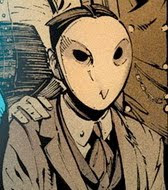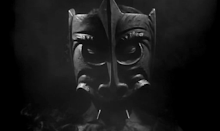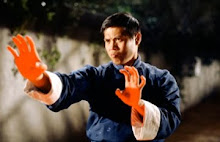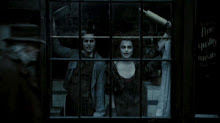.jpg)
“My father says there’s only right and wrong, good and evil, but it ain’t that way is it?”
“No it’s not it should be, but it ain’t.”
-Ride The High Country”-
If the above words aren’t inscribed on Peckinpah’s tombstone they should be. It is hard to think of another film so early in a director’s career that so completely captures their ethos as Ride The High Country. Romantic in a classical sense but deeply cynical, a crowd pleading genre film with poetry in its soul, a hard uncompromising work about men out of time and out of their time, Ride The High Country neatly sums up almost everything that makes Peckinpah Peckinpah.
Many people call Peckinpah a nihilist. I’ve always found this analysis to be laughably shallow. The second line alone proves that. Peckinpah was a dyed-in-the-wool romantic; he believes that there should be order, and despairs at finding none. Most nihilistic writings I’ve read have a distasteful smugness to them, as though the authors are overjoyed that the world gives them so many events to prove their philosophy. It is true that most Peckinpah films look at life with the view that friendship (Pat Garret and Billy the Kid, Ride The High Country), family (Junior Bonner), and love (Bring Me The Head Of Alfredo Garcia) will inevitably be betrayed, but he gets no satisfaction from these events only deep sorrow. These films are pitched at the level of an elegy, never a celebration of this loss.
It is amazing that Peckinpah was able to catch this tone as a young filmmaker. World weariness is usually distasteful and annoying when filmmakers who have not had significant reason to be world weary attempt to affect it (witness Vincent Gallo). Ride the High Country does not feel like a young man’s film. The entire world has been rundown, the characters have been defeated by life, the old carry deep wounds close to the surface, and the young have no idealism. The West no longer holds the promise of the clean slate that the frontier once provided, and the society that is encroaching is no better. The tenets of civilization have eroded, as Elsa discovers when she realizes that the family she has married into intends to share her in more ways then one and the community she has been brought into heartily endorses this arrangement (the frankness of this scene is somewhat amazing considering the code had not yet lost its power). The authority from the state, personified by the judge is drunken and corrupt, and other traditional sources of authority such as the church as conspicuously absent (the judge even underlines this when he begins his marriage ceremony with the words “This is not a religious ceremony and I am not a man of the cloth”). The violence is realistic, and it hurts.
While the violence in Ride The High Country is by no means graphic, it is realistic in the unblinking way it stares at death. There is a lovely echo in Pat Garret and Billy The Kid to a scene in Ride The High Country. In Pat Garret and Billy The Kid, when Slim Pickens is mortally wounded he calmly makes his way down to a river and quietly watches as his life leaks away, in what is perhaps the most touching scene Peckinpah ever filmed. In Ride The High Country, when one of the villains is shot he simply slumps over, holds his chest, and takes one last look at the surrounding wilderness. Despite our disdain for the character the scene is truly touching. The unsentimentality of the scene is underlined, when Randolph Scott returns to the scene of the killing to find that the dead man’s brothers have not even bothered to remove the body. The man is dead, and there is simply no way around it.
Sam Peckinpah is so often discussed as a stylist that the level of realism he brought to his films is all too often forgotten. As in his portrayal of the mining camp, which presages McCabe and Mrs. Miller by over a decade, and at least matches that masterpiece in its harsh reality. This is not the proto commune of Paint Your Wagon, or the boomtown of the classic Hollywood western. This is a dank dirty little hole where desperate men and hard women have decided to make their living. The miners live in pathetic ripped tents. The few buildings that do stand teeter ominously above the ground. The insides are dark, cramped, and rotting. The film uses long takes to allow the viewer to reveal the world to the viewer in the Bazianian sense.
Many scenes in this sequence have a strange Altman like intimacy and objectivity with characters viewed at the end of long hallways, and discussions conducted in deep shadow and long shot, these shots are held not vivisected with reassuring close-ups. As a result we are able to study the place where the characters and we find themselves, and despite the horror being more understated then say The Wild Bunch, we are able to grasp the sickness of this parody of civilization. This sickness is emphasized in the subjective shots from the young Elsa Fisher’s point of view. Finally running away from her tyrannical puritan of a father she finds herself thrown head first into the insanity of the camp. The garish colors of the whorehouse, the bestial nature of her husband(s), and the assortment of drunks and other unrespectables in the corner make this as dizzying indictment of humanities ugliness and appetites as anything Fellini directed.
We have an interesting contradiction in Ride The High Country. Peckinpah is known as the director who popularized the use of montage in American film. Using it in cases of strong violence or emotion to create an inescapable trap, time became elastic and with the aid of slow motion Peckinpah could make a horrible moment seemingly last forever, trapping us like insects in amber desperate to move past what it was we thought we wanted. However, in Ride The High Country the entire power of the film’s style is derived from the mise en scene, there is hardly a quick cut in the entire production and the film achieves the invisible style of the classical era of Hollywood.
The basis of the films mise en scene is all in the contrast. The righteous Joel Mc Crea is shot from low angles emphasizing his power and moral certainty. Randolph Scott is often shown from high angles and standing on a lower plane to emphasize his lack of moral firmness compared to Mc Crea. The film further emphasizes this in the sequence where Scott redeems himself in the final gunfight. We are given a low angle tracking shot as the heroes march on the villains. They now stand equally and as they march abreast they seem to tower over the screen itself.
Like all westerns the mise en scene comparing civilization to the wilderness are of great importance. However, this being Peckinpah the contrast between the two is a bit different from the directors of the classical era. Unlike John Ford who emphasized the frontiers mysterious and poetic beauty, or Howard Hawks who saw it a giant playground for a mans man to have fun in, Peckinpah takes the Cormac McCarthy route, painting the frontier as a place that will swallow the blood of the dead and strip the flesh and bleach the bones of the forgotten. While the landscape is not quite as harsh at it would become by Pat Garret and Billy The Kid, or say Bring Me The Head Of Alfredo Garcia, the landscape is not sentimentalized, the mountains are dust choked, the forests are thin and scraggly, and the exteriors in the mountain camp are a blighted frozen chunk of misery where nothing living grows.
It is something of cliché to say that Orson Welles lived out his own version of Citizen Kane; however, I would posit that it is equally true that Peckinpah lived out his own version of Ride The High Country, as a man who stuck to his principles when it seemed as though the entire world was struggling to get him to compromise.





































































































2 comments:
Thanks for being the first person to contribute to my Peckinpah tribute month - and for posting such a detailed and insightful article.
'Ride the High Country' really is something special - a quantum leap from Peckinpah's compromised debut 'The Deadly Companions' and an assured and intelligent statement of virtually all the themes and concerns that would go on to define his work.
And Joel McCrea and Randolph Scott turn in late-period career bests.
Thanks for the kind words, and for doing the blog-o-thon.
I love Scott especially, when you compare this movie to his Boetticher's and just how morally perfect he is in those versus here, where he's just this great shifty bastard. He's just having so much fun in the role.
Post a Comment